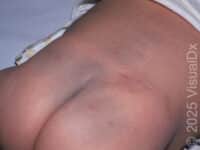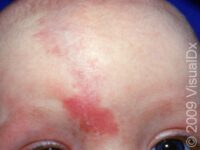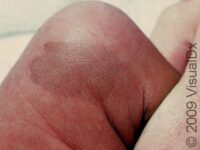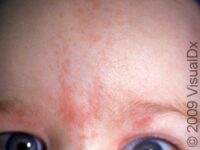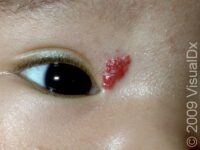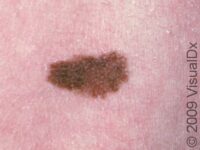Birthmarks are marks or lesions present on a baby’s skin at birth. These marks can range from small to large; flat to raised; and paler than the surrounding skin or darker, redder, or bluer. They can be caused by abnormal numbers of skin pigment cells or by abnormal blood vessels in the skin. Some birthmarks go away entirely on their own, and some persist or worsen into adulthood. Birthmarks are usually only of cosmetic concern, but certain types of skin lesions pose increased risk for skin cancer later in life or may be indicators of other serious diseases.
Some very common birthmarks include blue-grey spot (formerly known as Mongolian spot), café au lait spot, salmon patch, and port-wine stain.
Blue-grey spot:
- A flat patch of skin slightly darker and bluer than the surrounding skin, usually found on the lower back or buttocks of an infant.
- May be large enough to cover the whole lower back or buttock area.
- Usually develops in the first weeks of life and usually fades within a few years.
Café au lait spot:
- A flat patch of skin that is slightly darker or tanner than the surrounding skin.
- Found anywhere on the body in any size, though usually smaller than a child’s hand.
- These do not go away on their own and they appear to grow as the child grows.
Salmon patches and port-wine stains are birthmarks caused by abnormal growth of very small blood vessels beneath the skin.
Salmon patches:
- Extremely common, these occur in more than half of healthy babies.
- Reddish-pink patches located on the face or the back of the neck.
- Those on the face typically disappear before the toddler years, but the neck patches tend to persist until adulthood, though they are usually covered by hair.
Port-wine stains:
- Appear anywhere on the body, though the head and neck are common sites.
- At birth, are reddish-pink stains that gradually become darker and more raised over a person’s lifetime.
- These do not go away on their own.
Other less common birthmarks include congenital melanocytic nevus and infantile hemangioma.
Congenital melanocytic nevus:
- A mole, or darkly colored patch of skin, present at birth.
Infantile hemangioma:
- An abnormal growth of blood vessels that is raised.
- Not always apparent at birth but becomes evident in the first weeks of life as a raised, reddish or blueish, ladybug-or-larger-sized blemish.
- May appear to grow for the first few months of life and then gradually begin to shrink again, though the overlying skin will never look entirely normal.
- Most hemangiomas are gone by age 10.
Click any of the images below to gain medical information about the different types of birthmarks, such as how to distinguish one birthmark from another, and learn about potential birthmark removal.
